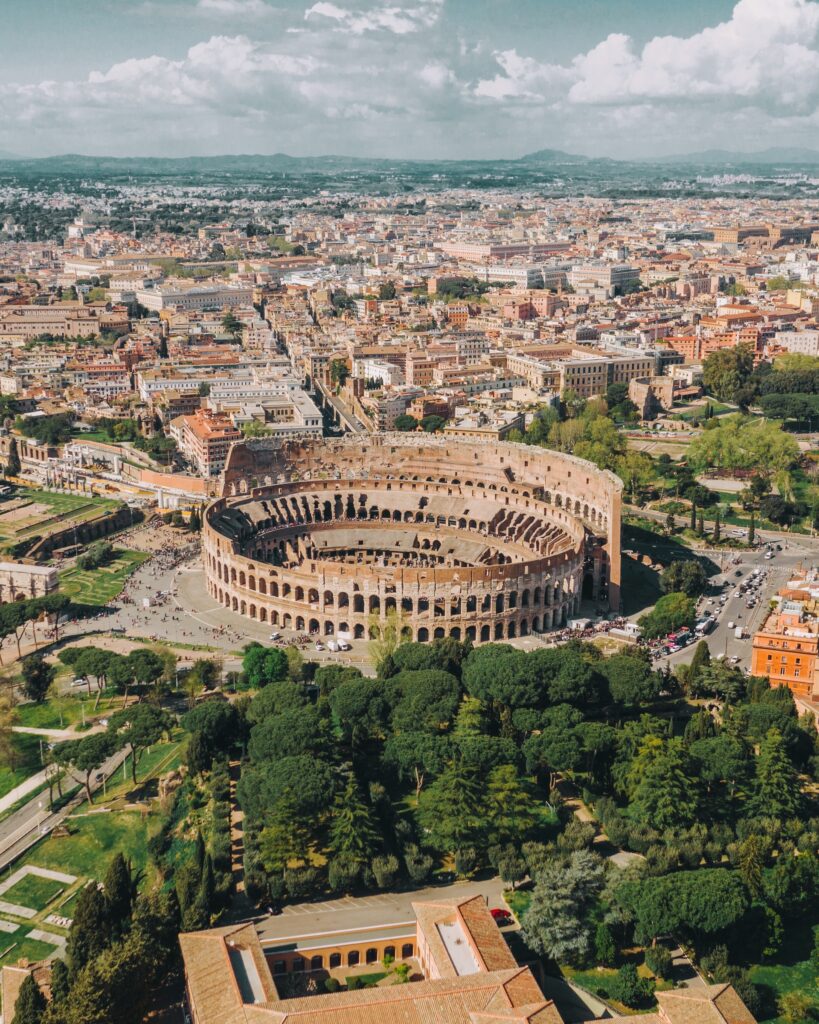Colosseum in Rome: Defining Roman Empire
Colosseum in Rome is one of the most important monuments of Italy. It is the largest amphitheatre on the globe. It is impossible to find an amphitheatre of this scale in the Modern World. That is exactly why it gains so much attention. Also, it couldn’t miss making an entry in the Seven Wonders of the World. Colosseum, in the heart of Rome, Italy is most famous for gladiator fights in the past.
A Brief History:
The age of the imposing structure is 2000 years and its history takes us back to the lifestyle of ancient Romans. Constructed in AD 80, the arena can host 50,000 spectators at once. In ancient times, the Colosseum in Rome was the venue for various activities. It held events like gladiator fights, animal hunts, chariot races, drama, exhibitions of exotic animals, and plays. All these events took place for 500 years. However, later it started suffering from lootings, earthquakes, and bombings. With the fall of the Roman Empire and the gradual change in public taste, the gladiatorial fights also came to an end. The last occasion celebrated here was in the 6th Century.
It also served as a storehouse, church, and cemetery for decades. However, later, it became a quarry for various building projects.

The architecture of the Colosseum in Rome:
- Colosseum in Rome overtook the site of the tyrannical emperor’s palace complex. Moreover, the central artificial lake of the palace was drained to be converted into a public amphitheater.
- This largest amphitheater in the World has an oval base of 189 x 156 meters and is 57 meters in height. The arena measures 87.5 meters x 54.8 meters.
- The four-story-high oval-shaped structure is spectacular at every inch, with three visible floors and one basement floor.
- The access inside the Colosseum of Rome is from 80 entrances of which 2 were for gladiators, 2 for emperors, and 76 for the visitors.
- The exterior of the structure has open arcades on the three upper floors filled with statues. The arcades also feature a combination of Doric, Ionic, and Corinthian orders on the first, second, and third levels respectively. The top floor also consists of a few rectangular windows.
- The basement tour of the Colosseum in Rome takes you to a completely different world. It has rooms where gladiators would wait for their fights. It also had cages for wild beasts.
Interiors of Colosseum in Rome:
The interiors of the Colosseum in Rome were majorly divided into three parts, the arena, the cavea, and the podium.
The Arena:
The central part of the amphitheater had wooden flooring, covered in sand. The purpose of such flooring was to prevent the warriors from slipping and to soak up their blood. The access to the underground chambers and passages beneath the arena was through trap doors. There were also ramps and staircases which allowed the great entry of participants on the stage.
The Cavea:
Cavea, the seating area had 3 levels. The lower tier was for magistrates and senior officials. The middle tier was for the wealthy citizens. The topmost for the ordinary people from the lower class.
The Podium:
Podium is a broad terrace placed in front of the Cavea, which was reserved for senators, emperors, and VIPs.
The Structure of Colosseum:
Colosseum in Rome is a free-standing stone and concrete structure. It has a complex barrel and groin vault system.
The main structural framework and facade are in travertine. The secondary walls are in volcanic tufa whereas the inner walls and the arcade vaults are of concrete.
Preservation of the Colosseum:
The Colosseum lost most of its grandeur after standing strong for over 5 centuries. When Colosseum was built, it attracted endless visitors. However, with time all its activity stopped. It got damaged by various events of lightning, earthquakes, and wars.
Late 20th Century saw the restoration of the Colosseum in Rome. Thereafter, it became Rome’s greatest tourist attraction.

Astonoshing facts about Colosseum in Rome:
- The Colosseum drew its name from the Colossus of Nero. It was a 30-meter high bronze statue. It was located near the Colosseum. However, the statue disappeared after an earthquake in the 7th Century AD.
- There were over 30 trapdoors in the arena. The gladiators had a special mysterious entry to the stage from either of these doors.
- The arena was filled with water for certain events. Thereafter, the battles were held on boats. This must have been surely an astonishing view.
- There is an underground passage connecting the nearby gladiator training center and the Colosseum.
- To easily capture your seat in these massive numbers of seating, you could find the numbers etched above each entrance and save yourself from the chaos.
- The stone and concrete structure took eight years and ten thousand men to complete its construction.
- The giant ancient amphitheater is capable to easily fit modern-day football ground.
- The entry to this marvelous public gathering space was mostly free. Free food was also served to spectators sometimes. However, it was basically a publicity stunt.
- Colosseum was full of brutal events; certain games killed over 10,000 animals in a day. In total, a million animals and half a million people died inside the Colosseum in Rome.
- The amphitheater also had a temporary canopy, Velarium, that could protect the seating area from sun and rains.
- However, there is an entry ticket to access the Colosseum in today’s World.
Two-third part of the Colosseum in Rome is open for tourists. The rest of the area is still mostly in ruins. The intricate amphitheatre with its simple geometry, massiveness, and hidden architectural gems has made its way in all of our hearts.







